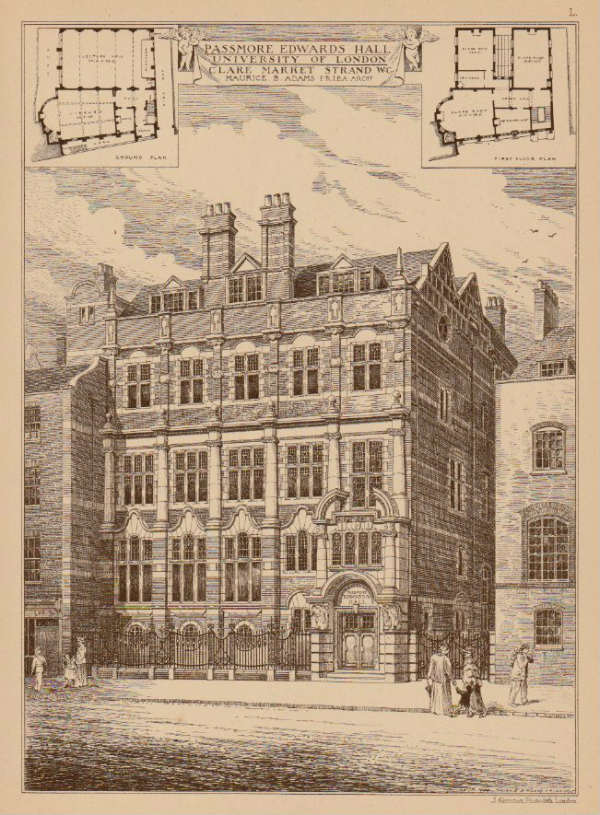On 30 May 1895 Beatrice Webb wrote in her diary ‘Yesterday the formal opening of the new building of the School of Economics, a day of satisfaction for Sidney, Hewins and myself, Our child born nearly 7 years ago in the back rooms in John Street with a few hundred a year from the Hutchinson Trust, despised by the learned folk as a young man’s fad is now fully grown and ready to start in the world on its own account.

History
The will of Henry Hutchinson, a member of the Fabian Society, established a Trust, with Beatrice’s husband, Sidney Webb, as Chairman – to dispose of the residue of his estate. When Hutchinson committed suicide in 1894 Webb decided to use the £10,000 available to establish a Central School of Economic and Political Science. Despite objections from leading Fabians, such as Bernard Shaw and Ramsey Macdonald, Webb pressed on, formed a committee and appointed William Hewins as first Director of the School.
Initially renting premises at 9 John Street, Adelphi, Hewins opened the School in October 1895, offering twelve courses of evening lectures and a three-year course in economics, economic history, and statistics. More than 200 students enrolled in the first term and this had risen to 281, including 87 women, by the end of the session. The following year, the school moved to more spacious premises at 10, Adelphi Terrace and with that move came the establishment of the British Library of Political Science. Seeking a permanent home for both the school and the library, the Webb’s launched their appeal; Beatrice wrote, ‘In vain I flattered Passmore Edwards’.
Sidney was, at first, no more successful. At the beginning of 1899 Edwards wrote to Sidney to say that although he agreed with Webb’s aims, he could not see how he could help as there were many knocking on his door for assistance. However, the very next day Webb received a further letter from Edwards, asking how many rooms would be needed, and how large, so that he could judge the costs involved; and a few days later, after further representations from Webb, another letter arrived to say that he hadn’t sufficient knowledge of the issues and asked Webb to visit. By the end of February Edwards wrote to say that he was prepared to provide a building and suggested that the Trustees should include the Rev Mandell Creighton, Bishop of London. The conditions of his offer, drafted by Webb, included that there should be adequate provision for evening study; recognition by the University of London of the subjects taught; and that the London County Council should provide adequate support from its annual grant to the University. With these assurances Edwards confirmed his offer of £10,000 for the building in a Trust Deed between himself, the Bishop of London, R Haldane QC, and Sidney Webb.
With Edwards’ close involvement in every one of his bequests, negotiations were to be both long and tasking; Edwards raising various objections to the terms the London County Council required.The Bishop of London laid the foundation stone in July 1900 by which time the School had been admitted as a school of the newly established faculty of Economics and Political Science within the University of London and in the year of opening, in 1902, the School was incorporated, with Sidney Webb as chairman of the Governors.
Passmore Edwards Hall, in Clare Market, designed by Maurice Adams, had cost £18,000, Edwards being persuaded to add another £1,000 to his original offer; Lord Rothschild giving £5,000; and the remainder coming from a long list of other subscribers. In the early years the majority of the classes were held in the evening with regular daytime classes not established until 1906. Expansion was rapid over the next decade, there were 2,137 students by 1912, and the requirement for additional accommodation needed to be addressed. Though delayed by the First World War, construction started in 1920 and by the start of the Second World War accommodation had more than doubled. As part of this expansion the Passmore Edwards building was reconstructed and incorporated into the new buildings, now totally unrecognisable. The only links to the School’s origins is in the Student Services Centre, created in 2002, the Passmore Edwards Room, and the foundation stone.
Current Use
Whilst it can not be argued that without Passmore Edwards’ money the LSE would not have developed, Webb’s determination would have overcome such a set back, it may have taken a number of years before the money was raised and this may have affected the way in which the school developed. Over the years the LSE has greatly influenced British society, developing relationships in politics, business and the law. Amongst those that have attended the LSE in recent years are Ed Milliband, Cherie Blair QC, and Shami Chakrabarti, former Director of the civil rights organisation, Liberty.